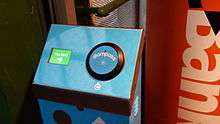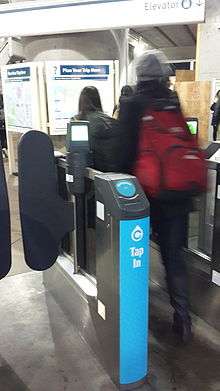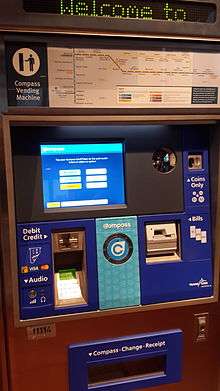Compass Card (TransLink)
  | |
| Location | Lower Mainland region |
|---|---|
| Launched |
September 2013 (beta)[1] August 2015 (public) |
| Technology | |
| Operator | Cubic Transportation Systems[2] |
| Manager | TransLink |
| Currency | CAD ($5 minimum through CVM purchase, $10 minimum online purchase, $175 maximum load) |
| Stored-value | Pay as you go |
| Auto recharge | AutoLoad (registration required) |
| Validity | |
| Retailed |
|
| Variants | |
| Website | compasscard.ca |
Compass Card is a contactless smart card payment system primarily used for public transit in Metro Vancouver, Canada. It is operated by Translink.
Riders purchase a Compass card and fare value online, by phone, or at vending machines located at SeaBus terminals, SkyTrain and West Coast Express stations. Vending machines are also available at 18 participating London Drugs retail store locations.[3]
Compass cards were deployed in August 2015.[4] Full deployment for the general public took place on November 2, 2015.[5]
Since April 4, 2016, Compass cards and tickets have been required for all trips taken on the SkyTrain and SeaBus.
In June 2016, Translink reported that 100 percent of monthly pass users and 95 percent of all other users have switched over to the new format, totalling more than 915,000 customers.[6]
Overview



Users start by obtaining a Compass card from one of the vending machines located at SkyTrain, SeaBus, or West Coast Express stations, then add value to the card online, by phone, or directly at the vending machines. In late October 2015 cards became available from Compass vending machines at London Drugs stores.[7] A card can be purchased at the customer service counter in any of these stores. Compass cards are also available for purchase wherever previous forms of transit fare media were available.
The current stored value for a card is available by submitting the "Compass No" at the Compass card website. These pages are not adapted to mobile device access and are not linked in the Translink website. For the user, the Compass number is not machine readable and must be submitted manually. If the user logs in, a history of usage and stored value can be viewed.
Once users obtain a Compass card with an adequate pass or an amount of stored value, they can tap in to enter a bus or transit station and tap out as they leave (except for buses). Tapping involves lightly touching the Compass card flat against a card reader.
Depending on the type of transit mode and vehicle the tap process differs slightly:
- Bus: riders tap card readers located at each bus door. Users are not required to tap out on a bus.
- SkyTrain and SeaBus: riders tap fare gates located at each entry and exit point of the station.
- West Coast Express: riders tap a free-standing validation machine located at each entry and exit point of the station.
When a rider starts their trip by tapping in at Skytrain or Seabus, the system will automatically reserve enough fare for three zones. Tapping out at the end of a trip will ensure that riders are only charged the fare for the distance (in zones) travelled. Failing to tap out at the end of the trip may result in a rider being charged a full three-zone fare even if only travelling one or two zones. If the trip is started from a bus, the system will only deduct fare for one-zone.
As riders transfer between transit modes or vehicles, such as when exiting a bus and entering a SkyTrain station, they must tap out and then tap back in. The system will automatically track transfers, ensuring riders are only charged once provided they are within the 90-minute transfer period (180 minutes for West Coast Express) and within the same transit zone.
Translink estimated that 80,000 users were using the system by the end of January 2014.[8] As of June 2016, Compass cards had been tapped on the system more than 371 million times, at a rate of more than 1.5 million every weekday. Translink recorded a ridership increase of 1.8 percent and 3.2 percent in increased fare revenues in 2015, according to its 2015 annual report.[9]
Fares
Transit riders will have the option of paying for fares by Compass card or cash, but the Compass card offers lower fares. A rider who makes cash payments at Compass vending machines receives a paper-based Compass ticket which is good for transfers within the 90-minute transfer period (180 minutes for West Coast Express).
Nearly half of Translink’s revenues come from fares. Translink uses a three-zone fare system in the region for SkyTrain, Canada Line, West Coast Express and SeaBus service, with single adult fares ranging from $2.75 to $5.50 on weekdays.[10] All fares on buses across the region are set at the one zone rate of $2.75, a switch Translink made during the roll out of the Compass contactless smart card payment system.
Users purchase a Compass card for a $6 (refundable) deposit, then load it with stored value. The $6 deposit can be used temporarily if a rider forgets to maintain enough stored value, but the card must be replenished to a positive balance before the next trip or they will not be able to tap in.
There are seven varieties of cards:[11]
- Light Blue — Adult
- Orange — Concession (children and seniors)
- White — CNIB
- Yellow — Contractors
- Dark Blue — Translink Employees
- Magenta Red — personalized Program Passes such as:
- BC Bus Pass Program clients (low income seniors and individuals receiving disability assistance from the Province of British Columbia)
- Access Transit/Handy Card[12]
- Green - 2016 Commemorative Limited Edition, for the opening of the Evergreen Extension. [13]
The paper-based Compass ticket are grey in colour with blue text (Adult) or orange text (Concession). Because of the smartcard circuitry laminate in between, it is not recyclable.[14]
Stored value
The following tables illustrates single trip fares during peak and off-peak hours for bus, SeaBus, and SkyTrain riders.[15]
| SeaBus and Skytrain (weekdays from start of service until 6:30pm) |
Zone 1 | Zone 2 | Zone 3 | YVR AddFare |
|---|---|---|---|---|
| Adult | $2.10 | $3.15 | $4.20 | +$5.00 |
| Concession | $1.75 | $2.75 | $3.75 | +$5.00 |
| Buses (all day) SeaBus and Skytrain (weekdays after 6:30pm, weekends, and holidays) |
All Zones | YVR AddFare |
|---|---|---|
| Adult | $2.10 | +$5.00 |
| Concession | $1.75 | +$5.00 |
Users must maintain a minimum of $0.01 value on the card to tap into buses, SkyTrain, or SeaBus, and a minimum of $4.50 to tap into West Coast Express.
Other passes
DayPasses, U-Passes, and one-, two-, or three-zone monthly passes can be loaded directly onto the Compass card, with the option to renew automatically every month. Users who register online benefit from the auto renewal and balance protection, which protects the stored value in the event of card loss or theft. Passes are used prior to Stored Value being used.
History
The Skytrain and Seabus network is barrier-free since its inception. BC Transit, and later, Translink, took the position that the barrier-free proof of payment system was more effective than having fare gates or turnstiles. In the early 2000s they estimated a five percent fare evasion rate, or approximately $2 million or less per year. Fare checks and fines issued inside 'fare paid zones' kept the rates at that level. Since the staff conducting the checks - SkyTrain Attendants and Transit Police - would still be required even with physical fare barriers, the cost of installing and maintaining a barrier fare system would be much more costly.[16]
In late 2007, the provincial Minister of Transportation, Kevin Falcon, announced interest in the installation of an access-controlled fare system.[17]
In March 2008, Ken Dobell, a lobbyist for Cubic Corporation, started talks with Minister Falcon with the intention of selling technology to Translink. Dobell, B.C. Premier Gordon Campbell's former deputy minister, had just been found guilty of breaching the Lobbyists Registration Act.[18]
Then, in April 2009, leading up to the provincial election campaign, the Office of the Premier, Government of Canada, and Translink announced the implementation of fare gates and smart cards.[19] The system is rolled out in November 2015.
Issues and controversies
_machine.jpg)
Issue with accessibility
Even on buses, users with physical handicaps may have difficulty tapping their card; this is even more apparent when they are faced with fare gates, which can completely prevent their access (bus drivers can waive the fare should they choose). The temporary solution was either having transit staff on hand to assist riders with difficulties, or keeping at least one fare gate per station open when staff was not present,[20][21] but they eventually closed all fare gates on July 25, 2016 and require those with disabilities which prevent them from using fare gates to contact Translink personnel for assistance[22]
Issue with bus
Buses still issue paper transfers with magnetic stripes, which are incompatible with the Compass system, requiring passengers to purchase additional Compass tickets in order to transfer to Skytrain or Seabus.[23] Translink claimed it would cost an additonal $25 million to provide fare box upgrades on buses enabling them to dispense and accept Compass tickets.[24]
In the original full tap-in/tap-out design, a multi-zone bus trip could be completed for a single zone fare by tapping out within the first zone of travel but remaining on the bus. This fault was not publicly acknowledged by the administration until system testing in September 2013.[25] Regardless of the loophole, Transit police or designated transit security fare enforcement officers may issue a fine if they catch riders without adequate fare in a Fare Paid Zone. Furthermore, the tapping out process on buses was reported to be slow, and failure to record a passenger's tapping out may have resulted in the passenger being charged for travelling through three zones when in fact they only travelled through one or two zones.[26]
On October 5, 2015, all bus travel throughout TransLink's system became 1-zone travel and bus passengers are neither required nor expected to tap out.
Delay in deployment and cost overrun
Despite a planned roll out in 2013, the full implementation of the system continues to be delayed by ongoing problems related to the bus tapping; this has been a serious setback for Translink as the entire system had been supposed to be operational by 2013. The time frame announcement was pushed to late 2014, before Translink changed its Compass Timeline website in late 2014 to remove statements promising a full Compass roll-out in late 2014, only stating that post-secondary students will receive cards in the summer of 2015, replacing the U-Pass BC, with full deployment not re-announced until September 2015.[27]
In addition, Translink confirmed in October 2013 that the cost overrun for the Compass Card system had reached $23 million due to delay related inflation and unanticipated scope creep. The Compass Card system had been budgeted at $171 million, but had risen to $194 million.[28]
References
- ↑ "TransLink Compass Cards: 8 things to know as testing winds down". Global News. Retrieved 1 October 2013.
- ↑ "Official Compass Card FAQ". TransLink.
- ↑ "London Drugs locations with Compass Vending Machines" (PDF). TransLink.
- ↑ "Compass Tickets—Coming Soon to a SkyTrain Station Near You!". Buzzer Blog (TransLink). Retrieved 26 August 2015.
- ↑ Jeff, Nagel (Nov 28, 2013). "Compass card rollout delayed for most transit riders". Retrieved December 9, 2014.
- ↑ "TransLink ridership, revenues increase due to Compass cards".
- ↑ "Compass Vending". London Drugs. London Drugs. Retrieved November 28, 2015.
- ↑ "Full TransLink's Compass Card roll out not until late 2014". Retrieved January 3, 2014.
- ↑ "TransLink ridership, revenues increase due to Compass cards".
- ↑ "TransLink launches first fare review in 30 years".
- ↑ "Ask Compass". Retrieved December 1, 2014.
- ↑ "sk Compass". Retrieved November 8, 2015.
- ↑ TransLink (December 2, 2016). "@fusionrockradio @h_escaravage There are a limited amount of commemorative Compass Cards, but they will be available until they run out!^kc" (Tweet) – via Twitter.
- ↑ http://www.metronews.ca/news/vancouver/2015/12/01/translink-says-compass-paper-tickets-are-not-recyclable.html
- ↑ "Compass Cards and Products". Translink. Translink. Retrieved September 26, 2015.
- ↑ "TransLink Cracks Down on SkyTrain Fare Evasion". TransLink.ca. Retrieved 2015-06-29.
- ↑ "Compass Card program delayed again by TransLink". cbc.ca. Retrieved 2015-06-29.
- ↑ "Ken Dobell gets absolute discharge". canada.com. Retrieved 2015-06-29.
- ↑ "Canada, B.C., TransLink Invest in Transit Security". Government of B.C. Retrieved 2015-06-29.
- ↑ http://globalnews.ca/news/2438633/translink-keeping-compass-card-gates-open-for-paralyzed-users/
- ↑ http://www.theglobeandmail.com/news/british-columbia/translink-sets-deadline-for-making-fare-gates-accessible/article29640376/
- ↑ http://www.cbc.ca/news/canada/british-columbia/translink-fare-gates-1.3686416
- ↑ Bus-to-SkyTrain transfers costly without smart card, Surrey Leader, 2013-08-14
- ↑ "SKYTRAIN WILL NOT ACCEPT BUS TRANSFERS WITH NEW TRANSLINK COMPASS CARD", Vancity Buzz", 2013-08-14
- ↑ "TransLink testers find Compass Card fare evasion loophole". CBC News.
- ↑ Sinoski, Kelly (29 October 2014). "TransLink's Compass Card system struggles with another glitch". The Vancouver Sun. Postmedia Network Inc. Retrieved February 4, 2015.
- ↑ "Compass Timeline". Translink. Translink. Retrieved December 1, 2014.
- ↑ "Compass Card upgrade costing extra $23 million: TransLink". CTV British Columbia. Retrieved January 3, 2014.